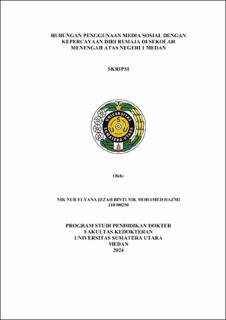| dc.description.abstract | Introduction. Social media platforms such as Instagram, TikTok, and YouTube
are popular among teenagers for self-expression, communication, and
information-seeking. However, exposure to social media can impact adolescents'
self-confidence, which is influenced by social interaction and self-perception. The
effects of social media can be either positive or negative, depending on usage
duration, content type, and purpose. Objective. This study aims to analyze the
relationship between social media use and self-confidence levels among high
school students at SMA Negeri 1 Medan. Methods. This study employed an
observational analytic method with a cross-sectional design, conducted between
July and October 2024 at SMA Negeri 1 Medan. The study population consisted
of 79 students selected based on minimal sample size calculations. Inclusion
xcriteria were active students at SMA Negeri 1 Medan, aged 15, willing to
participate as research subjects, while the exclusion criteria included students
who did not use social media. Data were collected through a Self-Confidence
Level questionnaire, and a Chi-square test was used to examine the correlation
between two variables, specifically the relationship between social media use and
self-confidence levels. Results and Discussion.The findings indicate that most
adolescents use social media for over 4 hours per day, primarily for
entertainment on platforms like Instagram, TikTok, and YouTube. Statistical
analysis showed significant correlation between duration of social media usage,
content consumed by adolescents and adolescents' self-confidence levels (pvalue
> 0.05). Conclusion. Social media use does have a relationship with selfconfidence
levels. | en_US |


